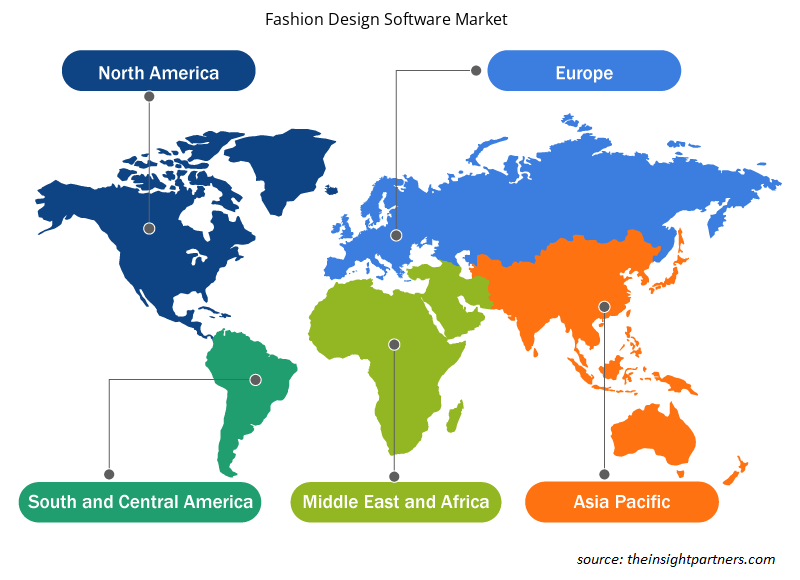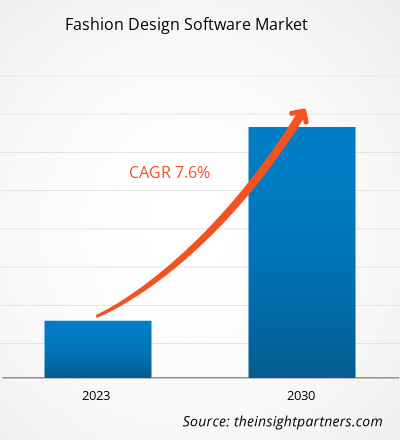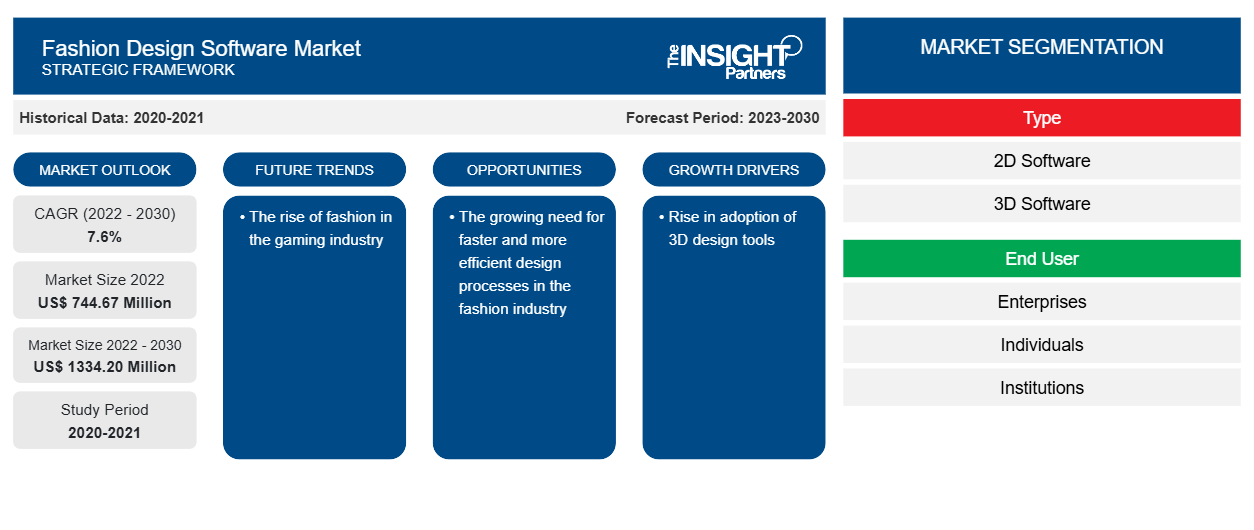ファッションデザインソフトウェアの市場規模は、2022年の7億4,467万米ドルから2030年には1億3,420万米ドルに達すると予測されています。市場は2022年から2030年の間に7.6%のCAGRを記録すると予想されています。A. ファッション業界における3Dデザインツールの採用の増加と、より迅速で効率的なデザインプロセスに対するニーズの高まりは、今後も市場の主要なトレンドであり続けると思われます。
ファッションデザインソフトウェア市場分析
ファッション デザイン ソフトウェア市場の重要な推進力の 1 つは、オンデマンド カスタマイズのトレンドが高まっていることです。ファッション意識の高まりと個性への欲求の高まりにより、消費者は自分の個性と価値観を反映したユニークでパーソナライズされた衣料品を求めています。ファッション デザイン ソフトウェアにより、デザイナーはカスタマイズ サービスを提供できるようになり、購入者は特定のニーズと好みに応じて購入品をプレビューして調整できます。Amazon Fashion や Louoj などの市場プレーヤーは、パーソナライズされたファッション体験の需要に応える仮想ツールと 3D デザイン カスタマイズ ソフトウェアをすでにリリースしています。重要な推進力の 1 つは、ファッション業界で 3D デザイン ツールの採用が増えていることです。ファッション デザイナーは、Adobe Illustrator、Bluecherry、Browzwear、C-Design Fashion などの高度な CAD スケッチ ツールを利用して、デザイン プロセスを大幅に強化しています。これらのツールにより、デザイナーは衣服をデジタルで作成および視覚化できるため、物理的なサンプル作成やプロトタイピングへの依存が軽減されます。複数のデザイン バリエーションを検討し、さまざまな素材やパターンに適用できるため、デザイン プロセスが合理化され、より革新的でユニークなデザインが生まれます。
ファッションデザインソフトウェア市場の概要
ファッション デザイン テクノロジーの幅広い採用により、アパレル、ファッション、ラグジュアリー (AF&L) 業界が製品を設計、開発、販売する方法が変わりつつあります。ファッション デザイン ソフトウェアは、ファッション デザイン開発プロセスを合理化し、時間とコストを削減するとともに、環境への影響も軽減します。世界中でデジタル化が進むにつれ、ファッション デザイン ソフトウェア ソリューションの採用が進んでいます。
要件に合わせてレポートをカスタマイズする
このレポートの一部、国レベルの分析、Excelデータパックなど、あらゆるレポートを無料でカスタマイズできます。また、スタートアップや大学向けのお得なオファーや割引もご利用いただけます。
- このレポートの主要な市場動向を入手してください。この無料サンプルには、市場動向から見積もりや予測に至るまでのデータ分析が含まれます。
ファッションデザインソフトウェア市場の推進要因と機会
ファッション業界の拡大
ファッションデザインソフトウェア市場の成長は、デザインツールや新技術の利用増加と、業界の拡大努力によって推進されています。2022年11月、CLO Virtual Fashionはミュンヘンとマドリードの既存オフィスに加えてパリに進出しました。このステップにより、フランスのファッションコミュニティにおけるファッションデザインテクノロジーの採用が促進され、世界中でより優れたサポートとサービスが提供できるようになりました。
発展途上国におけるソフトウェアソリューションの採用拡大
企業は、技術的に高度なソリューションを採用し、顧客とつながるための新しい方法を見つけています。このため、企業は 3D に向かっています。3D は、多くの技術的進歩の中心にあります。3D テクノロジーは、幾何学的データのグラフィカルな表現に役立ちます。さまざまなアプリの出現により、顧客は購入前にアバターで衣装を試着できるようになりました。これは、仮想的に何かを購入する際の疑問を解消するのに役立ちます。ファッションデザイン ソフトウェアにより、カスタマイズされた製品の作成も可能になりました。これは、「ファッション オンデマンド」と呼ばれています。インドのような国では、ファッションにはさまざまな意味合いと目的があります。総合的な教育に焦点を当てることで、倫理的で意識が高く、既成概念にとらわれずに考え、ソフトウェアの助けを借りて、これからの時代にもたらされる新しい問題や課題を解決できる学生やデザイナーが生まれることが期待されます。
ファッションデザインソフトウェア市場レポートセグメンテーション分析
ファッション デザイン ソフトウェア市場分析の導出に貢献した主要なセグメントは、タイプとエンド ユーザーです。
- ファッションデザインソフトウェア市場は、種類によって 2D ソフトウェアと 3D ソフトウェアに分かれています。3D セグメントは最も高い CAGR で成長すると予想されています。
- エンドユーザー別に見ると、市場は企業、個人、機関に分類されます。個人セグメントは最も高い CAGR で成長すると予想されます。
地域別ファッションデザインソフトウェア市場シェア分析
ファッションデザインソフトウェア市場レポートの地理的範囲は、主に北米、アジア太平洋、ヨーロッパ、中東およびアフリカ、南米および中米の 5 つの地域に分かれています。
北米地域は大きな市場シェアを占めています。この地域には、多くの成功したアパレルデザインおよび製造会社の本拠地があります。この地域のアパレルビジネスは新規参入を容易に受け入れており、政府の政策に関する参入障壁はほとんどありません。たとえば、2022年3月7日、カナダのNextechは、複数の3DモデルAR eコマース契約を締結しました。拡張現実(「AR」)体験テクノロジーとサービスの大手プロバイダーであるNextechaは、Nextechにとって新しいものを含む複数の業界で複数の3DモデルAR eコマース契約を締結したことを発表し、同社のeコマース3Dモデリング分野へのリーチをさらに拡大しました。
ファッションデザインソフトウェア市場の地域別分析
予測期間を通じてファッション デザイン ソフトウェア市場に影響を与える地域的な傾向と要因は、Insight Partners のアナリストによって徹底的に説明されています。このセクションでは、北米、ヨーロッパ、アジア太平洋、中東、アフリカ、南米、中米にわたるファッション デザイン ソフトウェア市場のセグメントと地理についても説明します。

- ファッションデザインソフトウェア市場の地域別データを入手
ファッションデザインソフトウェア市場レポートの範囲
| レポート属性 | 詳細 |
|---|---|
| 2022年の市場規模 | 7億4,467万米ドル |
| 2030年までの市場規模 | 13億3,420万米ドル |
| 世界のCAGR(2022年 - 2030年) | 7.6% |
| 履歴データ | 2020-2021 |
| 予測期間 | 2023-2030 |
| 対象セグメント | タイプ別
|
| 対象地域と国 | 北米
|
| 市場リーダーと主要企業プロフィール |
|
ファッションデザインソフトウェア市場のプレーヤー密度:ビジネスダイナミクスへの影響を理解する
ファッション デザイン ソフトウェア市場は、消費者の嗜好の変化、技術の進歩、製品の利点に対する認識の高まりなどの要因により、エンド ユーザーの需要が高まり、急速に成長しています。需要が高まるにつれて、企業は提供内容を拡大し、消費者のニーズを満たすために革新し、新たなトレンドを活用し、市場の成長をさらに促進しています。
市場プレーヤー密度とは、特定の市場または業界内で活動している企業または会社の分布を指します。これは、特定の市場スペースに、その市場規模または総市場価値に対してどれだけの競合相手 (市場プレーヤー) が存在するかを示します。
ファッションデザインソフトウェア市場で事業を展開している主要企業は次のとおりです。
- アドビ株式会社
- オートメトリックス株式会社
- ブラウズウェアソリューションズ株式会社
- CLOバーチャルファッションLLC
- レクトラSA
- ハーパー・アリントン出版有限責任会社
免責事項:上記の企業は、特定の順序でランク付けされていません。

- ファッションデザインソフトウェア市場のトップキープレーヤーの概要を入手
ファッションデザインソフトウェア市場のニュースと最近の動向
ファッション デザイン ソフトウェア市場は、主要な企業出版物、協会データ、データベースなどの一次調査と二次調査後の定性的および定量的データを収集することによって評価されます。ファッション デザイン ソフトウェア市場の動向のいくつかを以下に示します。
- サウジファッション委員会は、名門マランゴニ研究所と提携して、新しいデジタルファッションデザインプログラムを開始すると発表した。5か月間のプログラムは、仮想的で実物そっくりの衣服やアクセサリーの作成を可能にするCLO 3Dデジタルファッションデザインソフトウェアの使用方法をデザイナーに教えることに重点を置いている。(出典:アルアラビーヤネットワーク、プレスリリース、2022年1月)
ファッションデザインソフトウェア市場レポートの対象範囲と成果物
「ファッションデザインソフトウェア市場の規模と予測(2020〜2030年)」レポートでは、以下の分野をカバーする市場の詳細な分析を提供しています。
- ファッションデザインソフトウェア市場の規模と予測(対象範囲に含まれるすべての主要市場セグメントの世界、地域、国レベル)
- ファッションデザインソフトウェア市場の動向、および推進要因、制約、主要な機会などの市場動向
- 詳細なPEST/ポーターの5つの力とSWOT分析
- 主要な市場動向、世界および地域の枠組み、主要プレーヤー、規制、最近の市場動向を網羅したファッションデザインソフトウェア市場分析
- 市場集中、ヒートマップ分析、主要プレーヤー、ファッションデザインソフトウェア市場の最近の動向を網羅した業界の状況と競争分析
- 詳細な企業プロフィール
よくある質問
The estimated value of the fashion design software market will be US$ 1334.20 million by 2030.
Adobe Inc, Autometrix Inc, Browzwear Solutions Pte Ltd, CLO Virtual Fashion LLC, Lectra SA, Harper Arrington Publishing LLC, Optitex Ltd, Strategies SA, TG3D Studio Inc, and Tukatech Inc are some of the key players operating in the fashion design software market.
The rise of fashion in the gaming industry is considered a key trend in the fashion design software market.
The global fashion design software market is estimated to register a CAGR of 7.6% during the forecast period 2022–2030.
The rise in the adoption of 3D design tools and the growing need for faster and more efficient design processes in the fashion industry are the key driving factors impacting the fashion design software market.
- 過去2年間の分析、基準年、CAGRによる予測(7年間)
- PEST分析とSWOT分析
- 市場規模価値/数量 - 世界、地域、国
- 業界と競争環境
- Excel データセット
- Parking Meter Apps Market
- eSIM Market
- Advanced Distributed Management System Market
- Online Exam Proctoring Market
- Electronic Data Interchange Market
- Barcode Software Market
- Maritime Analytics Market
- Cloud Manufacturing Execution System (MES) Market
- Robotic Process Automation Market
- Digital Signature Market
お客様の声
購入理由
- 情報に基づいた意思決定
- 市場動向の理解
- 競合分析
- 新興市場の特定
- 顧客インサイト
- 市場予測
- リスク軽減
- 業務効率の向上
- 戦略計画
- 投資の正当性
- 業界イノベーションの追跡
- 規制動向への対応
はい!レポートの範囲(目次)、レポートの構成、そしてレポート全体の価値を評価するのに役立つ厳選されたインサイトを含む、レポートの無料サンプルをご提供しています。 「サンプルをダウンロード」ボタンをクリックするか、お問い合わせの上、サンプルをお送りください。
はい、アナリストによるサポートはパッケージに含まれています。ご購入後、アナリストにご連絡いただき、レポートの洞察や手法についてご説明したり、調査結果がお客様のビジネスニーズにどのように当てはまるかご相談いただけます。
ご注文が完了すると、確認メールと請求書が届きます。
• 公開済みレポートの場合:4~6営業時間以内に、セキュリティ保護されたメールがお客様のメールアドレスに送信されます。
• 近日公開予定レポートの場合:ご注文は事前予約として記録されます。リリース予定日については、担当チームからご連絡し、最新情報をお知らせいたします。レポートが公開され次第、ご登録いただいたメールアドレスに配信いたします。
お客様の特定の目的に合わせてレポートをカスタマイズするためのオプションをご用意しております。特定の地域、業界セグメント、競合他社の分析、データカットなど、より深い洞察が必要な場合でも、当社のリサーチチームがそれに応じてレポートをカスタマイズいたします。ご要望をお聞かせください。お客様に合わせたご提案やスコープを喜んでご提供いたします。
レポートは、選択したライセンスに応じて、PDF形式またはExcelデータセットで提供されます。
PDF版では、完全な分析とビジュアルがすぐに読める形式で提供されます。Excelデータセットには、すべてのデータテーブルが含まれており、簡単に操作して詳細な分析を行うことができます。
ご購入時にライセンスオプションをご確認ください。または、ご購入に含まれる形式を確認するには、お問い合わせください。
当社の決済プロセスは完全に安全で、PCI-DSSに準拠しています。
当社は、すべての取引が業界標準のSSL暗号化で保護されるよう、信頼性の高い暗号化された決済ゲートウェイを使用しています。お支払い情報は当社のサーバーに保存されることはありません。認定されたサードパーティの決済代行業者によって安全に処理されます。
お客様の個人情報と財務情報は当社で安全に保管されますので、安心してご購入いただけます。
はい、まとめ買いの場合は特別価格をご用意しております。
複数のレポートをご購入いただく場合は、お客様のニーズに合わせてカスタマイズされたバンドルオファーまたは数量ベースの割引をご提供いたします。ご検討中のレポートのリストを弊社の営業チームまでお送りください。お客様に合わせたお見積もりをお送りいたします。
はい、もちろんです。
弊社のチームが、お客様が十分な情報に基づいて意思決定できるようお手伝いいたします。レポートの範囲、方法論、カスタマイズオプション、最適なライセンスなど、ご質問がございましたら、お気軽にお問い合わせください。 sales@theinsightpartners.com までご連絡ください。担当者が速やかにご連絡いたします。
はい、ご購入が完了すると請求書が自動的に生成され、ご登録いただいたメールアドレスに送信されます。
特定の形式で請求書が必要な場合や、追加情報(会社名、GST、VAT情報など)が必要な場合は、お気軽にお問い合わせください。喜んでご対応させていただきます。
はい、もちろんです。
レポートへのアクセスや受信に問題が発生した場合は、サポートチームがサポートいたします。ご注文情報を添えて、メールまたはライブチャットでお問い合わせください。問題を迅速に解決し、お客様が中断することなくレポートにアクセスできるようお手伝いいたします。















The List of Companies - Fashion Design Software Market
- Adobe Inc
- Autometrix Inc
- Browzwear Solutions Pte Ltd
- CLO Virtual Fashion LLC
- Lectra SA
- Harper Arrington Publishing LLC
- Optitex Ltd
- Strategies SA
- TG3D Studio Inc
- Tukatech Inc.



The Insight Partners performs research in 4 major stages: Data Collection & Secondary Research, Primary Research, Data Analysis and Data Triangulation & Final Review.
- Data Collection and Secondary Research:
As a market research and consulting firm operating from a decade, we have published and advised several client across the globe. First step for any study will start with an assessment of currently available data and insights from existing reports. Further, historical and current market information is collected from Investor Presentations, Annual Reports, SEC Filings, etc., and other information related to company’s performance and market positioning are gathered from Paid Databases (Factiva, Hoovers, and Reuters) and various other publications available in public domain.
Several associations trade associates, technical forums, institutes, societies and organization are accessed to gain technical as well as market related insights through their publications such as research papers, blogs and press releases related to the studies are referred to get cues about the market. Further, white papers, journals, magazines, and other news articles published in last 3 years are scrutinized and analyzed to understand the current market trends.
- Primary Research:
The primarily interview analysis comprise of data obtained from industry participants interview and answers to survey questions gathered by in-house primary team.
For primary research, interviews are conducted with industry experts/CEOs/Marketing Managers/VPs/Subject Matter Experts from both demand and supply side to get a 360-degree view of the market. The primary team conducts several interviews based on the complexity of the markets to understand the various market trends and dynamics which makes research more credible and precise.
A typical research interview fulfils the following functions:
- Provides first-hand information on the market size, market trends, growth trends, competitive landscape, and outlook
- Validates and strengthens in-house secondary research findings
- Develops the analysis team’s expertise and market understanding
Primary research involves email interactions and telephone interviews for each market, category, segment, and sub-segment across geographies. The participants who typically take part in such a process include, but are not limited to:
- Industry participants: VPs, business development managers, market intelligence managers and national sales managers
- Outside experts: Valuation experts, research analysts and key opinion leaders specializing in the electronics and semiconductor industry.
Below is the breakup of our primary respondents by company, designation, and region:

Once we receive the confirmation from primary research sources or primary respondents, we finalize the base year market estimation and forecast the data as per the macroeconomic and microeconomic factors assessed during data collection.
- Data Analysis:
Once data is validated through both secondary as well as primary respondents, we finalize the market estimations by hypothesis formulation and factor analysis at regional and country level.
- Macro-Economic Factor Analysis:
We analyse macroeconomic indicators such the gross domestic product (GDP), increase in the demand for goods and services across industries, technological advancement, regional economic growth, governmental policies, the influence of COVID-19, PEST analysis, and other aspects. This analysis aids in setting benchmarks for various nations/regions and approximating market splits. Additionally, the general trend of the aforementioned components aid in determining the market's development possibilities.
- Country Level Data:
Various factors that are especially aligned to the country are taken into account to determine the market size for a certain area and country, including the presence of vendors, such as headquarters and offices, the country's GDP, demand patterns, and industry growth. To comprehend the market dynamics for the nation, a number of growth variables, inhibitors, application areas, and current market trends are researched. The aforementioned elements aid in determining the country's overall market's growth potential.
- Company Profile:
The “Table of Contents” is formulated by listing and analyzing more than 25 - 30 companies operating in the market ecosystem across geographies. However, we profile only 10 companies as a standard practice in our syndicate reports. These 10 companies comprise leading, emerging, and regional players. Nonetheless, our analysis is not restricted to the 10 listed companies, we also analyze other companies present in the market to develop a holistic view and understand the prevailing trends. The “Company Profiles” section in the report covers key facts, business description, products & services, financial information, SWOT analysis, and key developments. The financial information presented is extracted from the annual reports and official documents of the publicly listed companies. Upon collecting the information for the sections of respective companies, we verify them via various primary sources and then compile the data in respective company profiles. The company level information helps us in deriving the base number as well as in forecasting the market size.
- Developing Base Number:
Aggregation of sales statistics (2020-2022) and macro-economic factor, and other secondary and primary research insights are utilized to arrive at base number and related market shares for 2022. The data gaps are identified in this step and relevant market data is analyzed, collected from paid primary interviews or databases. On finalizing the base year market size, forecasts are developed on the basis of macro-economic, industry and market growth factors and company level analysis.
- Data Triangulation and Final Review:
The market findings and base year market size calculations are validated from supply as well as demand side. Demand side validations are based on macro-economic factor analysis and benchmarks for respective regions and countries. In case of supply side validations, revenues of major companies are estimated (in case not available) based on industry benchmark, approximate number of employees, product portfolio, and primary interviews revenues are gathered. Further revenue from target product/service segment is assessed to avoid overshooting of market statistics. In case of heavy deviations between supply and demand side values, all thes steps are repeated to achieve synchronization.
We follow an iterative model, wherein we share our research findings with Subject Matter Experts (SME’s) and Key Opinion Leaders (KOLs) until consensus view of the market is not formulated – this model negates any drastic deviation in the opinions of experts. Only validated and universally acceptable research findings are quoted in our reports.
We have important check points that we use to validate our research findings – which we call – data triangulation, where we validate the information, we generate from secondary sources with primary interviews and then we re-validate with our internal data bases and Subject matter experts. This comprehensive model enables us to deliver high quality, reliable data in shortest possible time.




 このレポートの無料サンプルを入手する
このレポートの無料サンプルを入手する